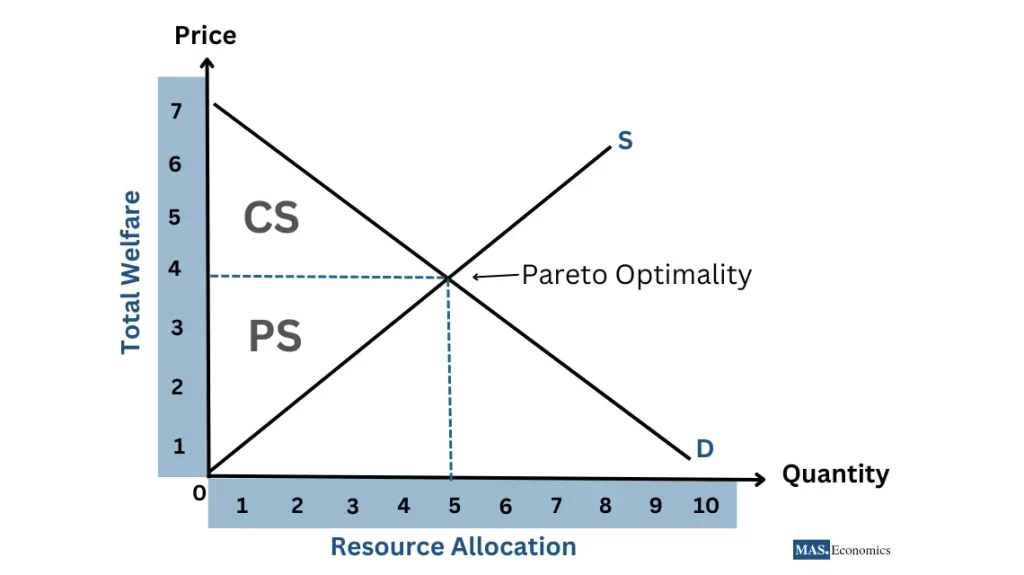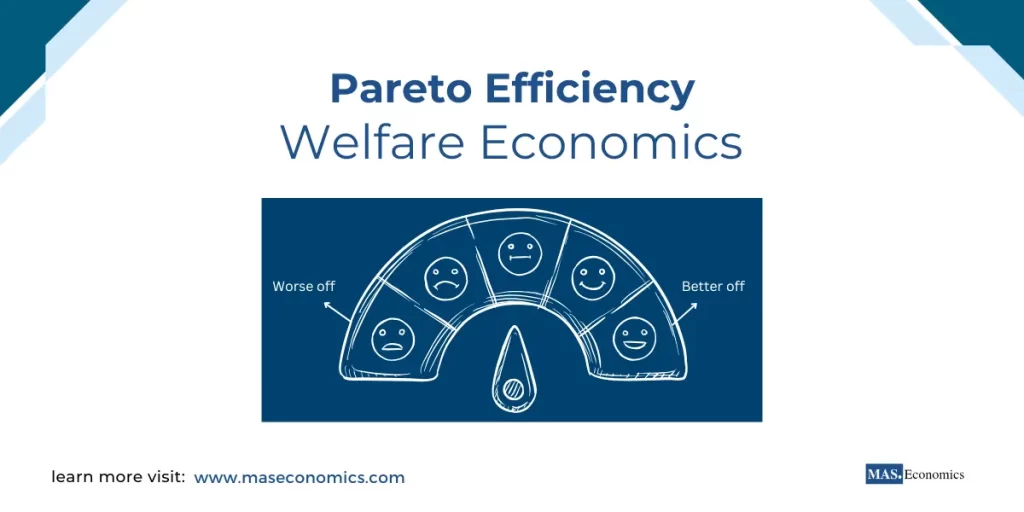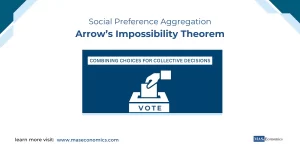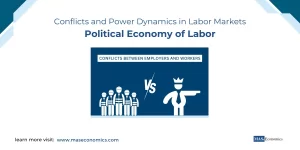Welfare economics is a branch of economic theory that focuses on the overall well-being and efficient allocation of resources in an economy. It evaluates how different economic policies, decisions, and conditions affect the welfare of individuals and society as a whole. A central concept in welfare economics is Pareto Efficiency (also known as Pareto Optimality), which refers to an allocation of resources where no one can be made better off without making someone else worse off.
This blog post dives deep into the core concepts of welfare economics, explains Pareto Efficiency, and explores the Fundamental Theorems of Welfare Economics, which underpin much of modern economic analysis.
What is Welfare Economics?
Welfare economics evaluates the desirability of different economic outcomes and policies based on how they affect societal well-being. It goes beyond mere financial gains to assess whether the allocation of resources maximizes the overall welfare of individuals and society.
Economists in this field study several key questions:
- How can resources be distributed to maximize total welfare?
- What trade-offs exist between efficiency and equity?
- How can government intervention improve societal outcomes?
Welfare economics often relies on concepts such as Pareto Efficiency, equity, and social welfare functions. Efficiency focuses on the optimal use of resources, while equity considers the fairness of their distribution. Achieving both is the ideal, but these goals may often conflict, as efficient outcomes may not be equitable, and vice versa.
Pareto Efficiency (Pareto Optimality)
Named after the Italian economist Vilfredo Pareto, Pareto Efficiency is a state of resource allocation where it is impossible to make one individual better off without making another individual worse off. This is used to judge whether a given allocation is economically efficient.
In a Pareto Efficient outcome:
- Resources are allocated in a way that no further changes can improve one person’s well-being without hurting someone else.
- The economy operates at its highest level of efficiency, meaning any reallocation of resources involves a trade-off between individuals’ well-being.
Example of Pareto Efficiency
Imagine a scenario where John and Jane share a set amount of goods—say apples and oranges. If John has three apples and Jane has three oranges, there is no way to give John more apples without taking some away from Jane. In this case, making John better off necessarily makes Jane worse off. This state represents Pareto Efficiency because any further redistribution would harm at least one person.
Importantly, Pareto Efficiency does not necessarily mean an equitable distribution. One person might have much more than another, but the allocation could still be Pareto Efficient if redistributing would make someone worse off.
Understanding Pareto Efficiency Through Mathematical Modeling
To understand Pareto Efficiency more rigorously, consider an economy with two individuals, A and B, and two goods, X and Y. Each individual has a utility function that reflects their well-being from consuming goods:
- Utility of A: \( U_A(X_A, Y_A) \)
- Utility of B: \( U_B(X_B, Y_B) \)
Pareto Efficiency is achieved when there is no feasible reallocation that can improve one person’s utility without decreasing the other’s. This is expressed using the Marginal Rate of Substitution (MRS):
\( MRS_A = MRS_B \)
Where MRS_A and MRS_B are the rates at which individuals A and B are willing to trade one good for another without changing their utility levels. In simpler terms, for an allocation to be Pareto Efficient, everyone must value the trade-off between goods in the same way.
First and Second Fundamental Theorems of Welfare Economics
The Fundamental Theorems of Welfare Economics provide a theoretical foundation for understanding how markets can lead to efficient resource allocations under certain conditions. These theorems also clarify when government intervention may be necessary to improve welfare outcomes.
First Fundamental Theorem of Welfare Economics
The First Theorem states that under certain conditions, a competitive market will naturally lead to a Pareto Efficient allocation of resources. In other words, when markets operate without distortions (like monopolies, externalities, or public goods), the “invisible hand” of the market will ensure resources are allocated efficiently.
Key assumptions include:
- Perfect competition: No firm or individual has the power to influence prices.
- Complete information: All market participants have full knowledge of prices and goods.
- No externalities: No spillover effects impact third parties.
Example of the First Theorem
Consider a perfectly competitive market for wheat. Farmers produce wheat, and consumers purchase it, with the price determined by the interaction of supply and demand. In this case, the First Theorem suggests that the equilibrium price and quantity will lead to an efficient allocation of wheat, where no one can be made better off without making someone else worse off.

Second Fundamental Theorem of Welfare Economics
The Second Theorem takes this idea further, suggesting that any Pareto Efficient outcome can be achieved through a redistribution of resources, followed by market competition. Essentially, this theorem indicates that equity and efficiency can be separated: governments can redistribute income or resources to reduce inequality, and markets can still efficiently allocate resources afterward.
Example of the Second Theorem
Suppose wealth is unequally distributed in a society. The government could redistribute income through taxes and subsidies to ensure a more equitable wealth distribution. Once the redistribution occurs, the market can take over to allocate resources efficiently, achieving a Pareto Efficient outcome while addressing fairness concerns.
Marginal Conditions of Pareto Optimum
The Marginal Conditions of Pareto Optimum provide technical criteria for achieving Pareto Efficiency in various markets. To achieve Pareto Optimality, the following must hold:
Marginal Rate of Substitution (MRS)
This is the rate at which one good can be substituted for another without changing the level of utility. For Pareto Efficiency, all consumers must trade goods in the same proportion.
Marginal Rate of Transformation (MRT)
This refers to how one good can be transformed into another in production. The MRT between two goods must be equal to the MRS for all consumers.
Marginal Cost Pricing
The price of goods must equal their marginal cost of production, ensuring resources are used where they are most valued.
Example of Marginal Conditions
Consider two goods—apples and oranges—and two consumers, Alice and Bob. The marginal rate at which Alice is willing to trade apples for oranges must be the same as Bob’s willingness to trade. Likewise, the production process that transforms apples into oranges must match the marginal cost of producing both goods. When these conditions are satisfied, the economy achieves Pareto Optimality.
The Broader Implications of Welfare Economics
Welfare economics provides a framework for understanding not just the efficiency of resource allocation but also its fairness. Economists often use Pareto Efficiency as a benchmark to determine whether resource allocations are optimal. However, it is important to remember that Pareto Efficiency does not guarantee equity, and achieving a balance between these two objectives is one of the primary challenges of welfare economics.
The Fundamental Theorems of Welfare Economics help illustrate how markets can achieve efficient outcomes, and when government intervention may be required to achieve equitable ones. Governments can use tools like taxes and subsidies to correct market failures and ensure resources are distributed more fairly, without sacrificing efficiency.
Conclusion
Welfare economics offers a crucial lens for analyzing how resources can be allocated efficiently while considering societal well-being. Concepts like Pareto Efficiency and the Fundamental Theorems of Welfare Economics help economists strike a balance between equity and efficiency. Meeting the Marginal Conditions of Pareto Optimum ensures that resources are used in the most efficient way possible, promoting both individual and collective welfare.
FAQs:
What is welfare economics?
Welfare economics is a branch of economic theory that focuses on evaluating how economic policies, resource allocation, and market conditions affect societal well-being. It assesses whether the distribution of resources maximizes overall welfare, taking into account both efficiency (optimal resource use) and equity (fair distribution of resources).
What is Pareto Efficiency?
Pareto Efficiency, also known as Pareto Optimality, is a state of resource allocation where no individual can be made better off without making someone else worse off. It represents an efficient allocation of resources, though it doesn’t necessarily mean the distribution is fair or equitable.
What is the difference between equity and Pareto Efficiency?
Pareto Efficiency focuses on the efficient use of resources, meaning that no one can be made better off without making someone else worse off. Equity, on the other hand, refers to the fairness of the distribution of resources. An allocation can be Pareto Efficient but highly unequal, meaning one individual might have significantly more resources than others.
What are the First and Second Fundamental Theorems of Welfare Economics?
- First Theorem: In a perfectly competitive market with no distortions (such as externalities or monopolies), the market will naturally lead to a Pareto Efficient allocation of resources.
- Second Theorem: Any Pareto Efficient outcome can be achieved by redistributing resources (e.g., through taxes or subsidies) and then allowing the market to allocate resources efficiently.
What are the key assumptions behind the First Fundamental Theorem of Welfare Economics?
The First Theorem assumes perfect competition, complete information, no externalities, and the existence of well-functioning markets. If these conditions are met, the market will allocate resources efficiently without any need for government intervention.
What is the difference between the Marginal Rate of Substitution (MRS) and the Marginal Rate of Transformation (MRT)?
- Marginal Rate of Substitution (MRS): It is the rate at which a consumer is willing to trade one good for another while maintaining the same level of utility.
- Marginal Rate of Transformation (MRT): It is the rate at which one good can be transformed into another in production, reflecting the opportunity cost of producing one good over another.
For Pareto Efficiency to be achieved, the MRS for consumers must equal the MRT in production.
What is the significance of the Marginal Conditions of Pareto Optimum?
The Marginal Conditions of Pareto Optimum ensure that resources are used most efficiently in an economy. These conditions include the equality of the Marginal Rate of Substitution among consumers, the equality of the Marginal Rate of Transformation in production, and marginal cost pricing (where the price of goods equals their marginal cost).
Does Pareto Efficiency guarantee fairness?
No, Pareto Efficiency does not guarantee fairness. An allocation can be Pareto Efficient while being highly unequal. For example, one person might own most of the resources, and any reallocation would make them worse off, even if others are significantly disadvantaged.
Why is government intervention sometimes necessary to improve welfare outcomes?
Government intervention, through tools like taxes, subsidies, and regulations, may be necessary to address market failures such as externalities, monopolies, or unequal resource distribution. The Second Fundamental Theorem of Welfare Economics suggests that while markets can efficiently allocate resources, governments can intervene to achieve a more equitable distribution without sacrificing efficiency.
What are some criticisms of welfare economics and Pareto Efficiency?
Criticisms of welfare economics and Pareto Efficiency include the focus on efficiency without considering equity, the assumption of perfect markets and rational behavior, and the challenges of applying these concepts in real-world settings where market failures, information asymmetry, and transaction costs exist.
Thanks for reading! Share this with friends and spread the knowledge if you found it helpful.
Happy learning with MASEconomics




